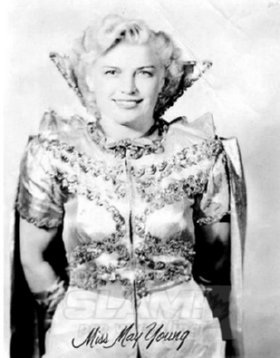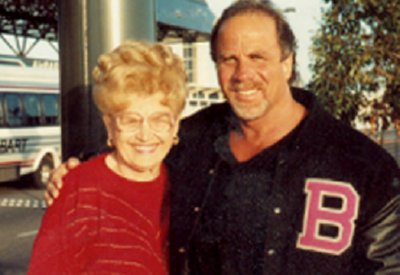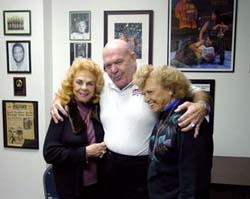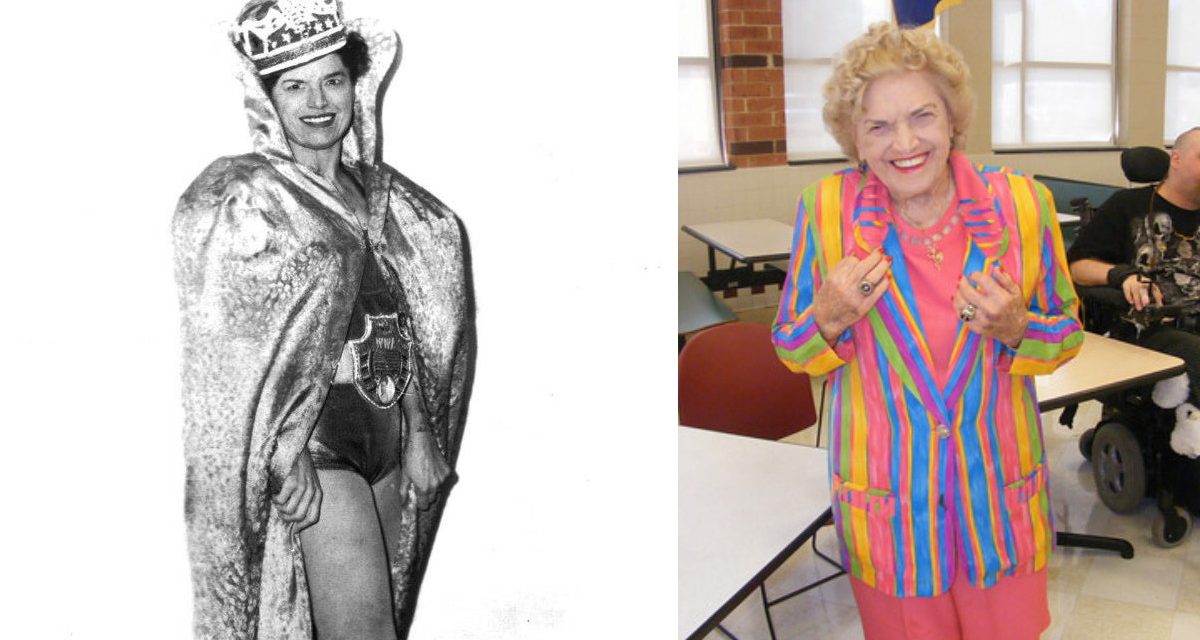Ed “Strangler” Lewis once told Mae Young, “I don’t like women’s wrestling, but if ever there was one born to be a wrestler, you’re it.”
With her passing Thursday at the age of 90, a link to the early days of women’s professional wrestling has been lost.
And make no mistake about it, Mae Young was there as women’s wrestling began to expand across North America and around the world; there was women’s wrestling before the likes of Johnnie Mae Young, June Byers, Mildred Burke, Mae Weston, and Gladys “Kill ‘Em” Gillem, but the post-World War II society was a little more accepting of the fact that women were deserving of equal billing as the male wrestlers.
She had a knack for the headlines, with the fights with men, the robbery charge, and her early history as an evangelist.

Miss May Young
It all started on March 12, 1923, in Sand Springs, Oklahoma, for Mae Young. It was at Sand Springs High School that she was introduced to the sport of wrestling — though she had already met Ed “Strangler” Lewis, who had connections to the town. “He was a big factor in my decision to become a wrestler,” Mae Young told writer Jeff Walton in 1968.
“My brother Fred was on the wrestling team when it was coached by Shag (Clyde) Charvoz,” Young told the Sand Springs Leader newspaper in 2008. “He showed me how to wrestle, so I learned amateur wrestling before I did professional wrestling.” Young competed on the boys’ high school wrestling team, and was a standout softball player, a part of a national championship team based out of Tulsa.
For her final two years of high school, Young worked at a cotton mill, but her calling in life came in Tulsa, where she saw Mildred Burke wrestle Gladys Gillem. According to the story that Young often told, she went up to the promoter and outright asked for a match with Burke. Though she was denied her request, it planted a seed. She said that he first official match was March 22, 1940 in High Point, NC, marking the beginning of her time on the road. By 1950, newspapers would promote her as a “veteran campaigner” who was an expert at “rough and tumble tactics.”
And did Johnnie Mae ever really stop wrestling? She always talked about wrestling when she turned 100: “I have on my 100th birthday an appointment to wrestle Stephanie McMahon’s daughter, Aurora Rose, and that’s gonna be my opponent on my 100th birthday,” Young told ClubWWI.com. “Stephanie has already promised me that I can do that, so I’m gonna do that. I’ll be there to it.”
But there is a lot of story to tell in between her wrestling debut and her passing on January 9 in Columbia, South Carolina. She had been hospitalized recently, and began getting hospice care. She was taken off life support on Wednesday.
For one thing, early on, Young did stop wrestling, and became a Christian preacher, like many in the pro wrestling business since.
“That was in Oakland, California. Well, my sister was involved in the church, and I went out there and got involved. I became an evangelist. I worked for two or three years as an evangelist,” Young recalled in 2011.
Was it something you enjoyed? “Yes I did.”
By 1947, she was back wrestling, and a story in the Abilene Reporter News reported that she is “back in the grunt and groan business just long enough to raise money to build a church and a school. Mae wants the school and church to be free for every one” and that “Mae plans to go back to Evangelizing when she has raised the money she needs for her religious work.”
It was hardly the only article written about Young.
The Washington Post noted that the “Oklahoma cowgirl” had changed since her last visit, when she wrestled in June 1943: “Mae, as blonde as the drug store would permit, was a hefty brunette when she last appeared here.”
In 1945, fellow woman wrestler Elvira Snodgrass talked about how Young got into trouble in Little Rock, Arkansas one night. “Young is a natural roughneck,” said Snodgrass. “This night in Little Rock she said something to a man fan and he kicked her in the face. Then Mae took him. His wife came to his assistance and Young sent both of them to the hospital. ” The aftermath was a trip to the jailhouse for Mae and a fine.
In 1949, there was a similar incident, though far more complicated that eventually saw Young exonerated. Elmer J. Nelson met Young at a restaurant, and went out on the town with her and a friend. Later, he was beaten and sent to hospital in Reno, Nevada, because of Young; he accused her of robbing him of $100. “Maybe I did work Mr. Nelson over a little,” Young confessed in an April 1949 United Press story. “He made advances to me. Improper advances.” Young and her companion, Mary Anice Huse, of Monrovia, Ala., were jailed, but later released when Nelson’s story didn’t quite add up.
Reporters did note the similarities between that story and one months earlier: “They were charged several months ago with beating Salvadore Manriquez of Sacramento, and dumping him from a car on the Pyramid lake road north of Sparks. Mr. Manriquez, who also reported his cash missing following the incident, almost died of exposure.”
The late Ella Waldek, another of the pioneering woman wrestlers, shared her thoughts on Young years back with writer Jamie Kreiser: “Mae’s okay. Very hard nosed. Gay person. She’s a typical lesbian. That was the man of the family, that’s the way she dressed and acts.” Waldek said that homosexuality wasn’t prominent in women’s wrestling when she first started, but as she continued in the wrestling business, recognized it as just part of the job. “I didn’t know there was such a thing until I met Mae Young. Well Dottie Dotson was gay as well, but she was bisexual. One night she’s talking about how many guys she was with and the next night she’s out with a woman,” said Waldek. “They kept it to themselves. Mae would put it in anyone’s face, but Dottie didn’t usually do that.”
Lillian Ellison — the Fabulous Moolah — would later become a constant companion of Young’s, bringing her from California to her South Carolina ranch in 1991.
In her autobiography, Moolah talked about the young Mae Young, who definitely helped teach Moolah some moves if she didn’t in fact actually train the Fabulous One: “These were wild times — and there were a lot of wild girls on the road back then. Mae was one of them. She used to like to go out drinking till all hours, smoking cigars and picking fights with big, bruising men in dark honky-tonks. She’d always laugh later about that expression on their face, a mixture of surprise and shame, just before they hit the floor after she’d conked them upside the head.”
The Great Mae Young may have have her rough sides, but was maternal as well, said former woman wrestler Beverly Lehmer. “Mae Young was like mother to me. She had a protective hand over me because I was young, innocent, like I didn’t fit in. I always felt like she was my protector.” Young never had any children of her own.
Young did not wrestle a lot in the 1950s, and tried other businesses, including work as an auto mechanic. But the lure of the pro wrestling business was too great, and by the 1960s Young had settled back in California. At the end of the decade, she opened a pseudo wrestling school at the Olympic Auditorium in Los Angeles. Young would work here and there for promotions in the area as Queen Mae Young. It was in the 1960s that she was recognized as the first women’s U.S. Champion as well.

Mae Young with her student Ric Drasin.
Her only graduate of any note was Ric Drasin, a bodybuilder from Bakersfield.
“She had a little room across from the booking office, upstairs at the Olympic. It had a linoleum floor with a padded canvas, and two, maybe three, ring posts. The rest was wall,” said Drasin. “The room smelled out Aquanet hair spray; that’s what she used a lot of. Any time I smell it today, I still think of her.”
Drasin wasn’t the only student there, but he is the only one who went on to a serious pro wrestling career. “She three girls and maybe one or two guys that never lasted; I don’t think any of the girls lasted either,” he said. “I trained there for six months. She charged me $25 a class — which was a lot of money back then. After a while, she stopped charging. ‘I’ll just take a percentage and I’ll book you, and you give me ten percent and we’ll go from there.’ I said, ‘Okay.'”
It was quality training from a “tough lady,” said Drasin. “I learned a lot because she said, ‘You’ve got to learn different styles. I want you to learn American style, but I also want you to learn Mexican style, Japanese style, and shoot style wrestling, because you’ll need it.'”
In a 1968 interview in Wrestling Revue, Young reflected on the doors that the women wrestlers of the 1940s and 1950s opened. “In the early days, a promoter would send two gals to wrestle in front of the Governor of a state in order for us women to be able to compete in that area. If the Governor liked what he saw, you were in,” she said.
For the most part, Mae Young flew under the wrestling radar in the 1970s and 1980s, though she would attend local shows, particularly those run by Woody Farmer around the Bay Area, and the Cauliflower Alley Club reunions in Studio City. Later, Young was a regular at Moolah’s LIWA reunions of women wrestlers in Las Vegas.
What most fans today remember her for, though, is her time on WWF television during the so-called “Attitude Era.” She and Moolah were involved in numerous memorable angles, and wrestled on occasions against women a quarter of their age, like Torrie Wilson and Dawn Marie, or male wrestlers.
It all kicked off with an angle with Jeff Jarrett, and Young recalled it for journalist James Guttman: “He banged Lil (Moolah) over the head with the guitar and I came into the ring and he put a step over toe hold on me. Yeah, I remember that very well. But WWF, I started wrestling for Vince McMahon Sr. I was one of the first girls to wrestle for Vince McMahon Sr. when he bought the Joe Turner Arena in Washington, DC. I was one of the first girls. Now how Moolah got started with WWE or WWF, Vince McMahon Sr, he asked me, ‘Johnnie Mae, I wanna ask you something. You know Lillian Ellison?’ I said, ‘Oh yeah. I trained her to wrestle.’ He said, ‘[Would] she want to come work for me?’ I said, ‘It would be the best thing you ever did, Vince is to get her.'”
There is little doubt that Young relished the spotlight. She was game for anything, from powerbombs on successive weeks from the Dudley Boyz, to giving “birth” to a hand with “Sexual Chocolate” Mark Henry as the father, to flashing her bared breasts — prosthetics — on television.
Dr. Ranjan Chhibber was a WWE TV writer and is now a Professor of the Humanities and Popular Culture at Florida State College. He shared a story on the dynamic duo from 2004: “Mae and Moolah were inseparable backstage and emanated positive energy. I am happy that I got to meet them before their health problems. In fact, a few months before I met them, they had a tag match against Torrie Wilson and Dawn Marie. Far from being a senior citizens comedy act, Mae Young brought the esteemed legacy of the past to 21st century Women’s Wrestling.”
Young’s influence during this period wasn’t just seen on television — she became a role model for many of WWE’s female competitors in an era where women’s wrestling went through evolutionary steps, from bra-and-panties-matches to the type of competition that Young and her cohorts pioneered.
“She was an inspiration, a true trailblazer… And one of the toughest SOB (women) I ever knew! I used to say to her, ‘When I grow up I want to be just like you’,” recalled WWE Hall of Famer Trish Stratus. “She opened the door for women in this business. I often hear how I paved the way but someone had to pave the way before me and that was Mae and of course Moolah.
“I’ll never forget how proud her and Moolah were of me when I won the championship for the first time and started to get out there each week — they were encouraging me and told me it was nice ‘to see a women doing some real wrestling for a change.’ They were my biggest cheerleaders, particularly in the beginning.”
Young was also featured in the 2004 documentary, Lipstick and Dynamite, bringing her colourful stories and colourful personality to a different audience.
Mae Young’s legacy is secure. She was inducted into the Pro Wrestling Hall of Fame in 2004, and was a proud supporter of it, attending every year even as her health — particularly her eyesight — failed.

It’s a George Steele sandwich between the Fabulous Moolah and Mae Young at the Pro Wrestling Hall of Fame in Amsterdam, NY, in 2004. Photo by Steven Johnson.
The Fabulous Moolah inducted Mae. “If it hadn’t been for her, I probably wouldn’t have been in the business,” said Moolah, before a video of Young in action as a youthful woman in action screened, set appropriately to Pat Benatar’s “Hit Me With Your Best Shot.” After accepting the induction ring and plaque, Young talked about just having signed a new deal with the WWE and her scheduled appearance with Moolah Sunday night in Columbia, SC. Then in an instant, she flipped back 60 years, and recalled a bout in Minnesota in 1939 with Bronko Nagurski as the referee where she flipped him over during the match, making the newspapers. “It touches me that you think enough of me to put me in the Pro Wrestling Hall of Fame,” she said. “This will be the greatest memory of my life.”
Similarly, she loved attending the WWE Hall of Fame induction ceremonies, and she was honoured there in 2008.
“I don’t hear from [Vince McMahon] until the last minute, but he always does have me at the Hall of Fame,” Young told this writer in 2011. “Vince is really, he’s a wonderful man. He does so much for all the older wrestlers. People don’t realize what Vince has done as far as the wrestlers, but he’s done an awful lot. I’m 87 years old. How many people do you see still working and on the payroll at 87 years old?
“I’ve been wrestling 70 years. I worked for Vince’s daddy. I’ve been around a long time.”
In 2011, she summed it all quite nicely: “That’s my life, the wrestling world.”
Funeral arrangements are not known at this time.
– with files from Jon Waldman
MAE YOUNG LINKS
- Jan. 5, 2024: The hidden history of Mae Young, wrestling promoter
- Jan. 9, 2014: Mae Young and the Dudley Boyz powerbomb
- Mar. 30, 2008: WWE HOF show had Flair
- Mar. 27, 2008: HOFer Mae Young vows to keep wrestling
- May 9, 2004: Pro Wrestling Hall of Fame Class of 2004 induction story
Greg Oliver met Mae Young many times, and she was always so sweet. One of the highlights of the Titans in Toronto dinners, which were fundraisers for the Pro Wrestling Hall of Fame, was having Mae Young and the Fabulous Moolah make a grand entrance.

